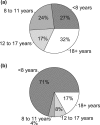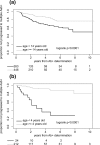Impact of Age and Antibody Type on Progression From Single to Multiple Autoantibodies in Type 1 Diabetes Relatives
- PMID: 28531305
- PMCID: PMC5546870
- DOI: 10.1210/jc.2017-00569
Impact of Age and Antibody Type on Progression From Single to Multiple Autoantibodies in Type 1 Diabetes Relatives
Abstract
Context: Islet autoantibodies are markers of type 1 diabetes, and an increase in number of autoantibodies detected during the preclinical phase predicts progression to overt disease.
Objective: To refine the effect of age in relation to islet antibody type on progression from single to multiple autoantibodies in relatives of people with type 1 diabetes.
Research design and methods: We examined 994 relatives with normal glucose tolerance who were positive for a single autoantibody, followed prospectively in the TrialNet Pathway to Prevention. Antibodies to glutamic acid decarboxylase (GADA), insulin (IAA), insulinoma-associated antigen 2, and zinc transporter 8 and islet cell antibodies were tested every 6 to 12 months. The primary outcome was confirmed development of multiple autoantibodies. Age was categorized as <8 years, 8 to 11 years, 12 to 17 years, and ≥18 years, and optimal age breakpoints were identified by recursive partitioning analysis.
Results: After median follow-up of 2 years, 141 relatives had developed at least one additional autoantibodies. Five-year risk was inversely related to age, but the pattern differed by antibody type: Relatives with GADA showed a gradual decrease in risk over the four age groups, whereas relatives with IAA showed a sharp decrease above age 8 years. Recursive partitioning analysis identified age breakpoints at 14 years in relatives with GADA and at 4 years in relatives with IAA.
Conclusions: In relatives with IAA, spread of islet autoimmunity is largely limited to early childhood, whereas immune responses initially directed at glutamic acid decarboxylase can mature over a longer period. These differences have important implications for monitoring these patients and for designing prevention trials.
Trial registration: ClinicalTrials.gov NCT00097292.
Copyright © 2017 Endocrine Society
Figures


References
-
- Bonifacio E. Predicting type 1 diabetes using biomarkers. Diabetes Care. 2015;38(6):989–996. - PubMed
-
- Insel RA, Dunne JL, Atkinson MA, Chiang JL, Dabelea D, Gottlieb PA, Greenbaum CJ, Herold KC, Krischer JP, Lernmark Å, Ratner RE, Rewers MJ, Schatz DA, Skyler JS, Sosenko JM, Ziegler AG. Staging presymptomatic type 1 diabetes: a scientific statement of JDRF, the Endocrine Society, and the American Diabetes Association. Diabetes Care. 2015;38(10):1964–1974. - PMC - PubMed
-
- Orban T, Sosenko JM, Cuthbertson D, Krischer JP, Skyler JS, Jackson R, Yu L, Palmer JP, Schatz D, Eisenbarth G; Diabetes Prevention Trial-Type 1 Study Group . Pancreatic islet autoantibodies as predictors of type 1 diabetes in the Diabetes Prevention Trial-Type 1. Diabetes Care. 2009;32(12):2269–2274. - PMC - PubMed
Publication types
MeSH terms
Substances
Associated data
Grants and funding
- UC4 DK106993/DK/NIDDK NIH HHS/United States
- U01 DK085461/DK/NIDDK NIH HHS/United States
- U01 DK106994/DK/NIDDK NIH HHS/United States
- U01 DK085453/DK/NIDDK NIH HHS/United States
- U01 DK107014/DK/NIDDK NIH HHS/United States
- U01 DK085504/DK/NIDDK NIH HHS/United States
- U01 DK085466/DK/NIDDK NIH HHS/United States
- U01 DK085465/DK/NIDDK NIH HHS/United States
- U01 DK085499/DK/NIDDK NIH HHS/United States
- U01 DK061010/DK/NIDDK NIH HHS/United States
- U01 DK085509/DK/NIDDK NIH HHS/United States
- U01 DK103153/DK/NIDDK NIH HHS/United States
- U01 DK061042/DK/NIDDK NIH HHS/United States
- U01 DK103180/DK/NIDDK NIH HHS/United States
- U01 DK103282/DK/NIDDK NIH HHS/United States
- U01 DK103266/DK/NIDDK NIH HHS/United States
- U01 DK085476/DK/NIDDK NIH HHS/United States
- U01 DK061058/DK/NIDDK NIH HHS/United States
- U01 DK106984/DK/NIDDK NIH HHS/United States
- U01 DK061034/DK/NIDDK NIH HHS/United States
- U01 DK107013/DK/NIDDK NIH HHS/United States
LinkOut - more resources
Full Text Sources
Other Literature Sources
Medical

